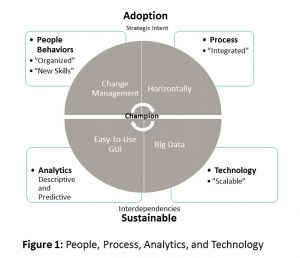There are four key areas that require continuous investment in order to become demand-driven: people, process, analytics, and technology. However the intent of your demand forecasting process along with business interdependencies need to be horizontally aligned in order to gain sustainable adoption. Adoption alone doesn't necessarily mean it will be sustainable.
As industry consultants and technology providers we continue to miss the mark when it comes to demand forecasting and planning. We all understand that there are four key investment areas that are critical to improve demand forecasting and planning; people, process, analytics and technology.  We know to be successful, this investment requires a Champion to facilitate adoption, but as the graphic shows, they must also ensure sustainability. Sustainability can only occur if the strategic intent and interdependencies are horizontally aligned supported by scalable technology.
We know to be successful, this investment requires a Champion to facilitate adoption, but as the graphic shows, they must also ensure sustainability. Sustainability can only occur if the strategic intent and interdependencies are horizontally aligned supported by scalable technology.
Companies are realizing that moving to the next generation demand management will require a laser focus on investing in their people’s skills, which requires change in behavior; reorganization around horizontal processes; integrating predictive as well as descriptive analytics into the process; and investing in large scale automatic demand forecasting technology. These four areas are the key catalysts to move from the current state to the future state, along with good metrics to measure progress. Although adoption requires changes in people behaviors that include new skills and horizontally integrated processes it will also require more focus on predictive analytics supported by scalable automated technology that can adapt and scale to big data. It requires changes in corporate culture led by a champion who has the authority and leadership to not only drive adoption, but create a new corporate culture that stresses accountability with a focus on customer excellence in order to maintain sustainability.
The primary goal is to create a strategic road map that supports the intent of the process in order to gain adoption and sustain that adoption long-term. Even if adoption occurs it must be sustainable by becoming part of the corporate culture. The key word is intent. Is your demand forecasting and planning organization intent to create accurate forecasts - aka lower MAPE’s - to set sales targets, create a financial plan, or to provide business decision support to grow revenue and profitability?
Why intent is so important?
Is your intent purely forecast accuracy focused around MAPE targeting reducing costs, setting sales targets and managing the financial plan? Or is it to understanding what is influencing demand by measuring and using those KPI’s (Key Performance Indicators) that influence demand using iterative what-if analysis? It’s not just about sensing the demand signal to create a more accurate demand response. Senior managers don't want to just sense the demand signal. They want to shape future demand. You cannot shape future demand using moving averaging and exponential smoothing models, even if the MAPE is better than a more advanced method. Furthermore, senior managers are willing to give up a few points of forecast accuracy to better understand what KPI's are influencing demand. Then, use those KPI's to shape future demand, thus growing revenue and profit. There needs to be a fine balance between forecast accuracy and understanding what KPI's are influencing demand.
In other words, senior managers are willing to give up precision in accuracy for precession in understanding what is influencing demand to drive (influence) revenue and profit. The core reason is that senior managers are not being measured on MAPE, but on profit and revenue growth. There is a fine balance between analytics and business relevance. It's not about whether your statistical model can beat a random walk model. It's about what KPI's your model can measure and use to shape future demand. Also, a more accurate demand response must grow revenue and profit, not just increase incremental demand, and/or reduce costs.
As a result, companies are transitioning from the traditional demand planner - who spends 80% of their time managing data and information - to demand analysts who can build more business relevant models that not only measure the demand signal, but can shape the future demand signal. They want to do this across the majority of the company's product portfolio for growth brands/products. They are looking for large scale interactive point-and-click interfaces that can take advantage of big data. As technology providers, we can no longer deliver black-box, lights-out solutions that focus solely on forecast accuracy using moving averaging and exponential smoothing methods.
So, are you focused on MAPE and reducing costs, or sensing KPI’s that influence the demand signal, and using those KPI’s to shape future demand? If it is the latter, then you are truly demand-driven.

2 Comments
Charlie,
Great article regarding the true focus we (as professional forecasters) should take to be relevant to the business. Otherwise, as you well pointed out, we run the risk of losing ourselves in the wilderness of MAPE (non-relevant to business, even less for sales teams)
Best regards,
Gerardo
Hi Gerardo,
Glad you liked the article. I can't agree with you more. It's about relevance to the business. If we are more relevant the chances of the business using our forecasts increases substantially.
Thanks again for your great feedback and comments.
Charlie